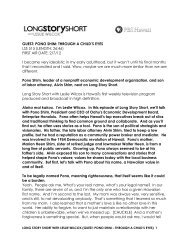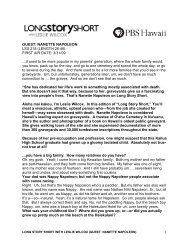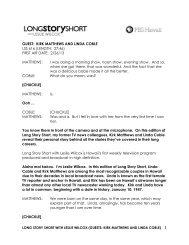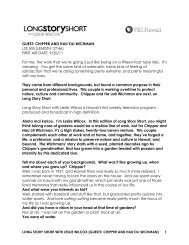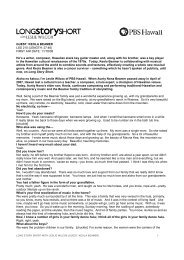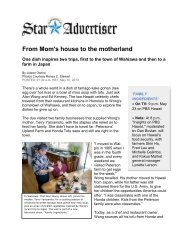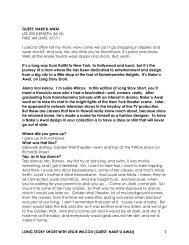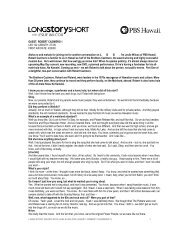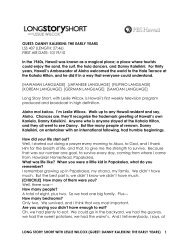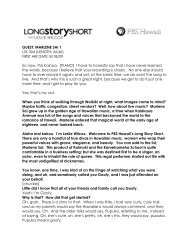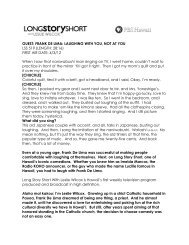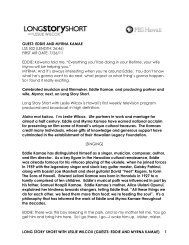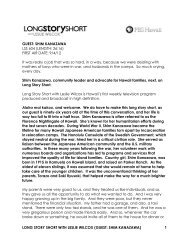GUEST: DeSOTO BROWN - PBS Hawaii
GUEST: DeSOTO BROWN - PBS Hawaii
GUEST: DeSOTO BROWN - PBS Hawaii
You also want an ePaper? Increase the reach of your titles
YUMPU automatically turns print PDFs into web optimized ePapers that Google loves.
<strong>GUEST</strong>: <strong>DeSOTO</strong> <strong>BROWN</strong><br />
LSS 317 (LENGTH 27:16)<br />
FIRST AIR DATE: 2/9/10<br />
People are…they’re coming to Bishop Museum to do the work, to look for things,<br />
and they’re looking to people there to help them. And it is a very satisfactory<br />
experience to go through, to be able to help people, not only with our<br />
collections, which can be complicated, and you do need guidance to get<br />
through those, but to also get the satisfaction of working with them and leading<br />
them to where they’re finding out what they want to find out.<br />
DeSoto Brown, a lifetime collector and <strong>Hawaii</strong>an historian has made a career<br />
of helping others find treasures of history at the Bishop Museum archives. Next<br />
on Long Story Short.<br />
Aloha mai kakou, I’m Leslie Wilcox. Welcome to Long Story Short. DeSoto Brown<br />
probably spends more time in the past than the present. At his job he’s<br />
surrounded by personal and political possessions from <strong>Hawaii</strong>an alii as well as<br />
stacks of other material representing our cultural and natural history. DeSoto<br />
Brown is the collections manager at Bishop Museum archives. When he’s not<br />
delving into the past at the museum, he’s pursuing his hobby collecting other<br />
artifacts. Love of history runs in his family, the Brown ohana traces its heritage<br />
back to a famous 19th century historian and writer, John Papa Ii.<br />
Tell me about where you were born, and how you grew up.<br />
Okay. Um, I was born in Honolulu. And I am happy to say I was born in the<br />
Territory of <strong>Hawaii</strong>, not the State of <strong>Hawaii</strong>. Then that makes me even older.<br />
And grew up in Honolulu, and have spent the great bulk of my life here. My<br />
mainland intervals have been pretty brief. So it’s been almost all just on this<br />
island.<br />
And your father, mother; what were they like?<br />
My father was a stockbroker, and he started his own company called the Brown<br />
Fund, which was the first locally started mutual fund. And my mother was what<br />
one would say was a housewife to a degree. She had five kids; she had a lot to<br />
do like that. She also did volunteer work, and both my parents as well as my<br />
grandmother were involved with Bishop Museum as volunteers. My dad was the<br />
first head of the Bishop Museum Association when that began in the early 1950s.<br />
That’s the membership organization.<br />
Your family goes back a long way in <strong>Hawaii</strong>. You’re related to John Papa Ii.<br />
LONG STORY SHORT WITH LESLIE WILCOX (<strong>GUEST</strong>: <strong>DeSOTO</strong> <strong>BROWN</strong>) 1
Yes. John Papa Ii was my great-great-grandfather. He is well known today as a<br />
<strong>Hawaii</strong>an historian. He wrote a series of newspaper articles. There’s a whole …<br />
as some people may know, there was a really large active amount of <strong>Hawaii</strong>an<br />
language newspapers which were published up until the 1940s. So for a little<br />
more than a century, there was a very active <strong>Hawaii</strong>an language press. And<br />
those newspapers didn’t just publish news the way we think of newspapers<br />
today; they published a lot of other stuff too, including historical things. And so<br />
John Papa Ii, towards the end of his life—he was born in 1800, wrote a series of<br />
newspaper articles reminiscing about his life. And they were not particularly in<br />
any order; it was just kind of anything that he chose to remember. And he’d<br />
been very closely involved with a lot of very important people. He was a friend<br />
of Kamehameha II, advisor to Kamehameha III, and the IV, and the V.<br />
He saw all the royal court happenings.<br />
He saw all this stuff happening, and he was in the Supreme Court, and so he<br />
personally experienced a great deal, not to mention the fact that he was born<br />
right at the start of Westerners coming here, well before the missionaries came.<br />
Anyway, so he lived a lot. And then my great uncle, Francis Brown, who was a<br />
famous golfer, and he was also in the Territorial Senate for many years. And his<br />
memory today is—his name is still out there, primarily connected to golf, and the<br />
Mauna Lani Hotel on the Big Island, and the golf course, and so forth.<br />
And there are other Browns of note.<br />
And there are other Browns of note. My Uncle Kenny, Kenneth Francis Brown, is<br />
my dad’s younger brother, and he’s been very active in kind of rediscovering his<br />
“<strong>Hawaii</strong>an-ness”, to a degree. I mean, that’s something that he worked on, in<br />
addition to his many other activities. That’s something that he explored a great<br />
deal as an adult to kind of bring himself back to his <strong>Hawaii</strong>an connections that<br />
he didn’t feel that he learned as much as a kid. I grew up hearing a lot of<br />
historical stuff discussed. When we were just driving around, my father or mother<br />
would say, Well, that was so-and-so’s house. And just that kind of stuff that I<br />
absorbed in conversation as to who was related to who, who said what; these<br />
things that added to my interest to want to pursue the road that I have, which is<br />
basically that I’m focused on <strong>Hawaii</strong>an history as my interest.<br />
And so what kind of a kid were you? You went to Punahou School.<br />
I went to Punahou School.<br />
You went to an elite boarding school in—<br />
Connecticut.<br />
—Connecticut as well.<br />
Yeah, right. And the irony is, the things that I studied in school ended up not<br />
being what I did for a living. I mean, and there are many other people like that<br />
too. My evolution towards “archivism”, if you will, was again, because my family<br />
had a connection to Bishop Museum, I was aware of the museum; I worked at<br />
the museum as a volunteer and some other things. And eventually, because<br />
the museum’s photo collection became a separate department, which was<br />
accessible to the public to go in and do research, I started doing that for my<br />
LONG STORY SHORT WITH LESLIE WILCOX (<strong>GUEST</strong>: <strong>DeSOTO</strong> <strong>BROWN</strong>) 2
own enjoyment. And in 1987 a job opened up there, and while I was not<br />
necessarily absolutely hundred percent qualified for that job, I learned on the<br />
job as to how to take care of things, as to how to go through stuff, put it in order,<br />
best storage conditions, how to catalog it, how to get people in to look at it; all<br />
of those things. And it’s exactly what I need to be doing in life, because it’s what<br />
I like to do.<br />
DeSoto Brown’s interest in history and collecting started in his childhood. At<br />
the tender age of seven or eight, he wanted to know what he missed, what<br />
happened before.<br />
I was interested in the 20th century, I was interested in what happened before I<br />
was born. I was just curious about it.<br />
That’s unusual, don’t you think?<br />
It’s extremely unusual, and that’s why I say, it just kind of was in me. But I wanted<br />
to know really basic stuff about, okay, what was daily life like. I mean, did you<br />
have TV? You had radio; what did it sound like? What were the programs?<br />
What were the magazines, what movies? I mean, to cars; all this basic stuff, I<br />
really was curious about. But not only that; I had a sense very early on of feeling<br />
that I had to save things. And the first thing—I mean, and this sounds somewhat<br />
absurd, but you’ll get the point. Every year, we’d get a new telephone book,<br />
and the old telephone book, you threw away. And I looked at that as a young<br />
child, eight years old, seven years old, and I thought, This is a big, thick—it’s like a<br />
book, and we’re throwing it away? Even at that point, I couldn’t even perceive<br />
that there was a use for telephone books, which now I know as an adult, that if<br />
you’re doing research, old telephone books are really helpful. I just somehow<br />
felt somebody needs to save this stuff.<br />
What came after phone books?<br />
Well, the other thing that really inspired me to be interested in old<br />
stuff was, my parents saved their old records. And so we would listen to old<br />
records, meaning records from the 1930s, 40s, maybe a few from the 50s.<br />
These are the vinyls?<br />
Uh, this is pre-vinyl. These are—<br />
Previnyl.<br />
—78s. Again, most people don’t even know this kinda stuff anymore, but 78s,<br />
ten inches, very breakable, if you dropped them, they broke. So I thought that<br />
those old songs—some of them I really liked, some of them I thought were sort of<br />
funny and stupid, but I just had that interest that, again, was part of what was<br />
going on in the old days kind of thing. By the time I was a teenager, I was going<br />
to the Salvation Army and Goodwill, and going through huge stacks of old<br />
records. They were really cheap, and I … if it looked like it was amusing or<br />
interesting, I’d buy it.<br />
And you would listen to them, obviously.<br />
And I’d listen to it.<br />
LONG STORY SHORT WITH LESLIE WILCOX (<strong>GUEST</strong>: <strong>DeSOTO</strong> <strong>BROWN</strong>) 3
So it wasn’t just having them, it was really knowing them.<br />
Exactly, exactly, exactly.<br />
Were you interested in only a certain period? You don’t want to go back too far,<br />
but—<br />
Correct. It was back to maybe the early 1900s. And the other thing that’s<br />
important too is, gradually I shifted or I kind of evolved by the time I was a<br />
teenager to realizing what really interested me the most was not general,<br />
general history, but history of <strong>Hawaii</strong>. I became intrigued by, how was <strong>Hawaii</strong><br />
advertised, how did people outside of here think of this place, and what made<br />
them think that type of thing. And I do remember at quite an early age<br />
watching occasionally a TV show, a national TV show about <strong>Hawaii</strong> would be on<br />
TV. And it was always somewhat ludicrous. And I remember thinking, This is<br />
interesting, because first of all, this isn’t like real life, but second of all, I live in this<br />
place that there are a lot of people interested in outside of here. They think it’s<br />
wonderful, they think it’s paradise. And that kind of led me to think, Why do they<br />
think this? So that led me to want to focus on tourist advertising, tourist<br />
promotion. What created it, why was it created?<br />
And who was doing it?<br />
Who did it?<br />
Were people who were really living here—<br />
Exactly.<br />
—knowing it, advertising it differently than it was?<br />
Exact and they were. And it took me a while to understand that looking<br />
back at the time that I didn’t live in, before my existence, it wasn’t all perfect,<br />
wonderful, paradise on Earth, the way these things might make it look. It was<br />
just like today, but you can’t rely on what these people are telling you in the<br />
advertising. That’s a big deal to realize.<br />
And then you look at history, and you say, Whoa, history is written by the victors.<br />
Totally. Totally, totally—<br />
—you can’t always—<br />
Totally, totally.<br />
—rely on that either.<br />
Absolutely. And so all of those things, I gradually—I mean, what you just said,<br />
these are things which gradually I evolved to understand. And what’s<br />
interesting to me is that I didn’t necessarily learn in a classroom. It wasn’t<br />
lectured to me, or told to me, but by accessing the original material, I absorbed<br />
it, and “archivally” speaking, that’s what’s called primary source material that<br />
comes directly from the original source. And that, again, made me realize that<br />
when I became an archivist, getting people to the original source is a really<br />
important thing. When you come across a batch of things that are particularly<br />
insightful or interesting, it’s so exciting. Because you learn all this stuff that you<br />
didn’t know, and it’s like somebody’s telling you right from the time, This is what it<br />
looks like, this is what it sounds like, this is what I think, this is what I feel.<br />
LONG STORY SHORT WITH LESLIE WILCOX (<strong>GUEST</strong>: <strong>DeSOTO</strong> <strong>BROWN</strong>) 4
DeSoto Brown is a gatekeeper of the Bishop Museum collections—he watches<br />
out for the treasures. But he also opens the door and inspires others to explore<br />
history through the experiences of people captured in letters, photographs and<br />
other memorabilia.<br />
Now, can anyone come in to Bishop Museum—<br />
Absolutely.<br />
—and say, I’d like to check out some beach scenes?<br />
Yup. Absolutely. The archives and library is open to the public, Wednesday,<br />
Thursday, Friday afternoons; Saturday mornings. You can just come in. You<br />
don’t need an appointment, you don’t need to have us pass judgment on what<br />
you want to do. If you want to just come in and look at stuff, you can just come<br />
in and look at stuff. We have people who are big-time commercial producers<br />
of national TV shows coming in, down to fourth graders doing projects for<br />
school. That’s really the reason that museums have stuff, and that’s the reason<br />
that people like me are working at museums. Because if you have the<br />
collections, and nobody gets to see them it’s somewhat pointless to have the<br />
collections. You have to have it so that people have access in order for it to be<br />
valid.<br />
What kind of collections, among the collections that you manage, do you have?<br />
What are some of the ones that our audience might find the most interesting?<br />
Okay; well in Bishop Museum archives, we have manuscripts, we have<br />
photographs, we have moving images, we have audio recordings, we have<br />
maps, and we have artwork. And they all have not only information, but they all<br />
have different separate appeal. I think for most people, the most accessible<br />
and most interesting, and most intriguing are the photographs. That’s the most<br />
immediate. And I think there’s an exercise I do when people come in to do<br />
research or when they come in for an orientation as to what the archives is like.<br />
And I show them a photograph and I say, Can anybody guess what this picture<br />
is of? And ninety-nine percent of the time, people don’t have clue. And it’s a<br />
picture of Kalakaua Avenue in Waikiki in 1945. And it doesn’t look recognizable<br />
at all. It looks like a little, small town America. There’s a gas station, there’s a<br />
drugstore, cars. It looks totally dissimilar from Waikiki today. And the reason I like<br />
to do that, and I tell people this, is because they can get an immediate<br />
reaction. When they hear where it really is, what this picture is of, they have an<br />
immediate emotional sort of connection to that. Wow, I can’t believe that.<br />
Seeing it touches your brain in a different area, and hearing what it is, you<br />
connect with it in a different way. There also are photographs of people that, at<br />
first glance, maybe don’t look too spectacular. But when you look at those<br />
people, you look at their faces, you look at their expressions, you see how they<br />
are standing with each other, or how they’re interacting with each other, how<br />
they’re posed with each other, and you see what they’re wearing. And<br />
sometimes they’re wearing their best clothes, and other times they’re wearing<br />
maybe what those were their best clothes, but they’re like farm clothes. And<br />
LONG STORY SHORT WITH LESLIE WILCOX (<strong>GUEST</strong>: <strong>DeSOTO</strong> <strong>BROWN</strong>) 5
those types of things, you kinda project into the picture, you make assumptions,<br />
and you try to conjecture what were their lives. And even if you don’t know the<br />
people, even if they’re not relatives of yours, they touch you.<br />
I know you’re very familiar, intimately familiar with so many things in the Bishop<br />
Museum vaults. Are there areas that are secret, you don’t know about?<br />
Well, there aren’t areas that are secret, but there are—just in the library—<br />
They’re sealed?<br />
—in archive well, they’re not, no. There’s nothing that’s sealed. And actually,<br />
that’s a very good question, because that is a perception that people have.<br />
Sometimes, people are a little angry about it, because they have the<br />
perception that you’re keeping things intentionally from them. And we don’t do<br />
that. There is one particular collection which was in fact sealed for many years;<br />
it’s called the Judd Collection, and it came from the Judd family. And it was<br />
not until the death of the last descendant who had control of that collection,<br />
which was several years ago, that it became available to the public. And that’s<br />
a really important large, significant collection of written material from 1820 up to<br />
about 1900, and it was kept by the Judds, who were very closely connected to<br />
the alii, and the government, and the military, so there’s a lot of important<br />
information. And that is available. But I think connected to what you just asked<br />
me, it’s not that things are kept secret, they’re not kept from people, but if you<br />
want to come in and look for stuff, you as the researcher have to be fairly<br />
dedicated sometimes. You have to be willing to really sit down, go through lots<br />
of stuff and with the anticipation you may not even find the information you’re<br />
looking for, because no one’s done that research already. So it’s not that it’s<br />
secret; it’s that you have to find it.<br />
Well, I would like to know what King Kamehameha truly looked like. Because<br />
I’ve seen the painting, as has everybody, a portrait, and it doesn’t look like a<br />
<strong>Hawaii</strong>an guy to me.<br />
Well, there are several things here. First of all, this is before photography existed.<br />
We can’t see a photograph of King Kamehameha I. The only source that we<br />
have is based on a series of portraits done by one artist whose name was Louis<br />
Choris, who was here in 1816 and 1817. And he did portraits of Kamehameha<br />
from life. Even though he sat there and looked at the man and drew a picture<br />
of him, artists still have, well I shouldn’t say they have prejudices. They’ve got<br />
elements, they’ve got influences in them that will affect the art that they create.<br />
Or maybe in this case, the man was thinking of the audience to whom he would<br />
sell the work?<br />
Exactly; that’s possible too. But I mean, you don’t know that all the time.<br />
Because it could have been that this artist was trying to be as closely<br />
documentary, as much of a “documentarian” as possible, I want this to look as<br />
close as possible. On the other hand, as we’ve been talking about earlier, there<br />
are times that people intentionally change things to influence the people<br />
who are gonna look at the painting, or as you said, maybe want to buy the<br />
painting. So when we talk about the early artwork of <strong>Hawaii</strong>, the portraits of<br />
LONG STORY SHORT WITH LESLIE WILCOX (<strong>GUEST</strong>: <strong>DeSOTO</strong> <strong>BROWN</strong>) 6
people or whatever they are, we have to realize that the artists who did these<br />
pieces were Westerners, they were Europeans mostly, but Americans as well.<br />
They came from a certain artistic tradition, they were taught in a certain way.<br />
Do you think Kamehameha I looked like that?<br />
I think he certainly looked like it. But how much of a difference there is, we can’t<br />
say. You know.<br />
We’ll never know.<br />
We will not—we will never know. That’s exactly right. We work with what we’ve<br />
got, and we make our best conclusions.<br />
See, I wish there were more. But maybe it’s in your files somewhere. Deep down<br />
in the files.<br />
I think we would have found it by now. But no, you’re absolutely right. I mean,<br />
it’s in looking through old stuff, you cannot help but wish so many times, why<br />
didn’t somebody do this, why didn’t they take a picture of that, why didn’t they<br />
write this down. And you know, you can’t go back and redo it; you work with<br />
what you’ve got.<br />
Now, how is it that there are so many letters, personal letters in the archives?<br />
Are these donated by family members?<br />
Things come to us in a number of ways, but very frequently, they do come from<br />
the families. They come from the descendants of the people who wrote them.<br />
But you raise another point which is really interesting. Letter writing; we don’t<br />
write things by hand very much anymore, and we’re gonna do that<br />
decreasingly as time passes. We write things electronically, and we don’t save<br />
those things. And even if we save them electronically, that is not saving them<br />
for a good long time. The only way that—the best really—the only way that you<br />
can be assured of that, you gotta print it on a piece of paper. That’s the way<br />
it’s gonna last the longest.<br />
I know there are so many, but what are another couple of things that you just<br />
feel so proud you have there?<br />
Oh, wow. That’s very difficult to do. One thing that is very important too, that<br />
has so much significance to it. After Liliuokalani was overthrown in 1893. And in<br />
1894, the Provisional Government became the Republic of <strong>Hawaii</strong>. In January of<br />
1895, there was the counterrevolution against the Republic of <strong>Hawaii</strong>, the Wilcox<br />
Rebellion. And Liliuokalani was put on trial as someone having assisted with that<br />
counterrevolution. She was found guilty, she was imprisoned in Iolani Palace.<br />
We have the pardon that was signed by Sanford Dole, the president of the<br />
Republic of <strong>Hawaii</strong>, pardoning Liliuokalani for her supposed role in the potential<br />
reestablishment of her as the ruler. And again, it’s this big ornate piece of<br />
paper, of course. It’s big, it’s ornate, it’s got things signed on it. But again, when<br />
it’s explained to you what’s going on, what’s the background of this thing? I<br />
mean, these are the people who overthrew her, are now saying, Oh, we pardon<br />
you? That’s—I mean, there’s a lot of emotion there, there’s a lot of other stuff<br />
going on. So documents like that, particularly when it’s explained to you, and<br />
you know the context, are very meaningful.<br />
LONG STORY SHORT WITH LESLIE WILCOX (<strong>GUEST</strong>: <strong>DeSOTO</strong> <strong>BROWN</strong>) 7
Archivists like DeSoto Brown want to make sure the past is carried into the<br />
future. They worry about the survival of Historic material.<br />
So what’s the future for archives?<br />
Well, there’s always gonna be stuff to archive. It is worrisome as, for anybody<br />
who’s an archivist or in the archive profession, because we are producing less<br />
and less stuff that’s easily preserved.<br />
Certainly, videos are a great new field for archivists, right? And videos can be<br />
preserved.<br />
Well, yes and no. I mean, just in the few—okay, well, the term that’s used<br />
“archivally” is moving images. That means something that produces a moving<br />
picture for you to look at. Well, just in that realm, there’s film, and there’s video.<br />
And there is movie film of all these different sizes; there’s thirty-five millimeter,<br />
there’s sixteen millimeter, there’s eight millimeter. Videotape; there’s two-inch,<br />
there’s one-inch, there’s—<br />
We’ve got—<br />
—three-quarter-inch.<br />
—all of it in this building.<br />
And it’s all sitting in this building right now. Well, no, actually, a bunch of it is<br />
sitting in this building at Bishop Museum. But anyway, and then we’re now in a<br />
technology where we remember things just on disc, if at all, or it’s on a hard<br />
drive. There are two problems. One is, all of those media, the physical thing<br />
deteriorates. You don’t necessarily know about it, it becomes unreadable for<br />
some reason, because the actual plastic it’s made of deteriorates. Plus, each<br />
one of those things requires a different machine to view it. If you don’t have the<br />
machine anymore, you can’t see it. Now, right here in this building that we’re<br />
sitting in right now, when it first was built in the 60s, they were using two-inch<br />
videotape.<br />
Right.<br />
That’s what they were taping their shows on. There are no working two-inch<br />
video players in <strong>Hawaii</strong> anymore.<br />
We’ve got to convert the tapes now.<br />
Well, you gotta find a working machine. And they don’t make them anymore,<br />
and they don’t make parts for them anymore. So people have a<br />
misconception of, if it’s digital, it will be there forever. And that’s not true.<br />
Because the machine it’s remembered on, the machine that needs to read it is<br />
not going to exist forever. So that’s what I said earlier; the best thing you can do<br />
is to print it on a piece of paper, put that in an acid-free envelope, in an acidfree<br />
box. That’s what’s gonna last. Not all the electronic stuff that we … that<br />
we depend on so much.<br />
So what are you collecting at home right now?<br />
What am I not collecting home is kind of the—no.<br />
You’re serious too, aren’t you?<br />
LONG STORY SHORT WITH LESLIE WILCOX (<strong>GUEST</strong>: <strong>DeSOTO</strong> <strong>BROWN</strong>) 8
Yeah, I am. The things that I am primarily interested in for my personal collection<br />
are, as I said earlier, the tourist-related sort of memorabilia or publications. And<br />
that includes postcards, it includes brochures and booklets published by<br />
different companies. It includes sheet music, and all kinds of…the general term<br />
for what I collect is ephemera, meaning it’s material that’s ephemeral, it was<br />
only intended to be used for a specific short amount of time, and then most of it<br />
got thrown away. The thing I like about ephemera is that a lot of times, it had a<br />
very big impact, but very little of it still exists. When you realize, okay, say they<br />
printed five hundred thousand of those over a certain amount of time, that’s<br />
reaching a huge amount of people, as opposed to a hardbound book, which<br />
may have only been five thousand copies.<br />
You know, I remember as a kid from those from ephemera. And this was not too<br />
ephemeral, ‘cause I think this was a concentrated campaign. But there was this<br />
gorgeous woman who stared out and smiled at us from tourist ads.<br />
Yes.<br />
Rose Alvaro, I think, her name.<br />
Yes; Rosemarie Alvaro.<br />
Rosemarie Alvaro.<br />
She was the <strong>Hawaii</strong> Visitors Bureau poster girl, quote, unquote. There were three<br />
of them in succession; Mae Bemis, Rosemarie Alvaro, and then Elizabeth Louge.<br />
And they got promoted exactly. They personified <strong>Hawaii</strong> to millions of people.<br />
Even those of us who were here, living it, we still got sucked into this promotional<br />
advertising fantasy world. And we kinda thought, Oh, yeah. No, it didn’t really<br />
look like that. We know that Rosemarie Alvaro was not sitting next to Rainbow<br />
Falls with a basket of Vanda orchids all the time. But we saw her—<br />
But you wanted to think that—<br />
And we just sort of—<br />
Sure.<br />
—went with it. We didn’t question it. And so if we were thinking that, how many<br />
people in North Dakota and Germany, and every place else were thinking that<br />
too?<br />
DeSoto Brown is at home when he’s at work, and he’s at work when he’s at<br />
home. He says his professional and personal lives blend into each other,<br />
because they’re all about understanding the past. After all of these years since<br />
he was a kid, sifting through and sorting out and sharing history, he’s lost none of<br />
his passion for it. I’d like to thank DeSoto Brown of Bishop Museum—and you—<br />
for joining me on Long Story Short on <strong>PBS</strong> <strong>Hawaii</strong>, I’m Leslie Wilcox. A hui hou<br />
kakou.<br />
Video clip with production credits:<br />
Did you do a lot of fantasy about time travel when you were a kid?<br />
Absolutely. Oh, yeah. I still wish I could. I don’t want to go back and stay<br />
someplace. I want to go back and visit it, and then come back to the present.<br />
LONG STORY SHORT WITH LESLIE WILCOX (<strong>GUEST</strong>: <strong>DeSOTO</strong> <strong>BROWN</strong>) 9
And there are lots of reasons I want to do that. But I don’t want to get stuck<br />
back there if I know what it’s gonna be like. I know what’s gonna come up, I<br />
don’t want to necessarily go through all that. So I want to go see it, then come<br />
back here.<br />
LONG STORY SHORT WITH LESLIE WILCOX (<strong>GUEST</strong>: <strong>DeSOTO</strong> <strong>BROWN</strong>) 10



